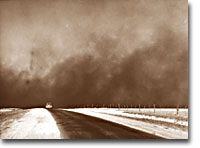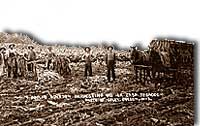49c. The Farming Problem

Years of plowing and planting left soil depleted and weak. As a result, clouds of dust fell like brown snow over the Great Plains.
Farmers faced tough times. While most Americans enjoyed relative prosperity for most of the 1920s, the Great Depression for the American farmer really began after World War I. Much of the Roaring '20s was a continual cycle of debt for the American farmer, stemming from falling farm prices and the need to purchase expensive machinery. When the stock market crashed in 1929 sending prices in an even more downward cycle, many American farmers wondered if their hardscrabble lives would ever improve.
The first major New Deal initiative aimed to help farmers attempted to raise farm prices to a level equitable to the years 1909-14. Toward this end, the Agricultural Adjustment Administration was created. One method of driving up prices of a commodity is to create artificial scarcity. Simply put, if farmers produced less, the prices of their crops and livestock would increase.
The AAA identified seven basic farm products: wheat, cotton, corn, tobacco, rice, hogs, and milk. Farmers who produced these goods would be paid by the AAA to reduce the amount of acres in cultivation or the amount of livestock raised. In other words, farmers were paid to farm less!

Adolph Johnson, a farmer in Rutland, Oregon, poses in front of his tobacco crop. The Agricultural Adjustment Act provided much needed relief for farmers by paying them not to grow crops, thus helping to adjust prices.
The press and the public immediately cried foul. To meet the demands set by the AAA, farmers plowed under millions of acres of already planted crops. Six million young pigs were slaughtered to meet the subsidy guidelines. In a time when many were out of work and tens of thousands starved, this wasteful carnage was considered blasphemous and downright wrong.
But farm income did increase under the AAA. Cotton, wheat, and corn prices doubled in three years. Despite having misgivings about receiving government subsidies, farmers overwhelmingly approved of the program. Unfortunately, the bounty did not trickle down to the lowest economic levels. Tenant farmers and sharecroppers did not receive government aid; the subsidy went to the landlord. The owners often bought better machinery with the money, which further reduced the need for farm labor. In fact, the Great Depression and the AAA brought a virtual end to the practice of sharecropping in America.
The Supreme Court put an end to the AAA in 1936 by declaring it unconstitutional. At this time the Roosevelt administration decided to repackage the agricultural subsidies as incentives to save the environment. After years and years of plowing and planting, much of the soil of the Great Plains and become depleted and weak. Great winds blew clouds of dust that fell like brown snow to cover homes across the region as residents of the "Dust Bowl" moved west in search of better times.
The Soil Conservation and Domestic Allotment Act paid farmers to plant clover and alfalfa instead of wheat and corn. These crops return nutrients to the soil. At the same time, the government achieved its goal of reducing crop acreage of the key commodities.

Issuing food stamps was a New Deal initiative designed to help farmers and consumers alike.
Another major problem faced by American farmers was mortgage foreclosure. Unable to make the monthly payments, many farmers were losing their property to their banks. Across the Corn Belt of the Midwest, the situation grew desperate. Farmers pooled resources to bail out needy friends. Minnesota and North Dakota passed laws restricting farm foreclosures. Vigilante groups formed to intimidate bill collectors. In Le Mars, Iowa, an angry mob beat a foreclosing judge to the brink of death in April 1933.
FDR intended to stop the madness. The Farm Credit Act, passed in March 1933 refinanced many mortgages in danger of going unpaid. The Frazier-Lemke Farm Bankruptcy Act allowed any farmer to buy back a lost farm at a law price over six years at only one percent interest. Despite being declared unconstitutional, most of the provisions of Frazier-Lemke were retained in subsequent legislation.
In 1933 only about one out of every ten American farms was powered by electricity. The Rural Electrification Authority addressed this pressing problem. The government embarked on a mission of getting electricity to the nation's farms. Faced with government competition, private utility companies sprang into action and by sending power lines to rural areas with a speed previously unknown. By 1950, nine out of every ten farms enjoyed the benefits of electric power.






